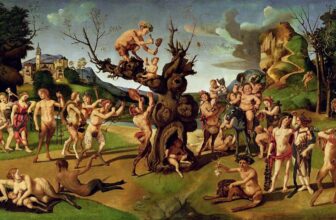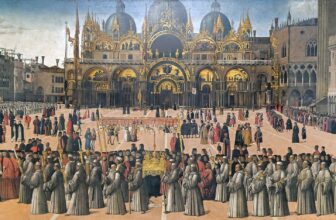
Who Commissioned the Mona Lisa Painting
There are few paintings in the world more universally recognized than Leonardo da Vinci’s Mona Lisa. Her enigmatic smile, subtle expression, and haunting eyes have captured the fascination of historians, artists, and admirers for centuries. But behind the iconic portrait lies a deeper story, one of patronage, marriage, mystery, and a family’s quiet place in history.
Who was the woman in the painting? Who asked for her to be immortalized on canvas? What made Leonardo spend nearly 16 years perfecting this masterpiece? And who was the man behind the Mona Lisa, the man known as Francesco del Giocondo.
Let’s peel back the layers of art, history, and speculation to discover the truth.
Who Commissioned the Mona Lisa
The most widely accepted theory among art historians is that Francesco del Giocondo, a Florentine merchant, commissioned Leonardo da Vinci to paint a portrait of his wife, Lisa Gherardini. The portrait later became known as La Gioconda in Italian and La Joconde in French, both referring to her married name.
The commission likely took place around 1503, when Leonardo had returned to Florence after spending years in Milan. By then, da Vinci was already a well-respected artist and thinker. He was working on multiple projects at the time, including The Battle of Anghiari, but he found time to accept commissions from wealthy patrons.
Francesco was a moderately successful silk merchant, not a nobleman, but a man of means. Commissioning a portrait of one’s wife was a sign of both status and affection, and Francesco likely wanted to capture Lisa’s beauty and dignity in a way that would be remembered for generations.
Interestingly, Leonardo never actually delivered the painting to Francesco. For reasons that remain unclear, the Mona Lisa stayed with Leonardo for the rest of his life, and he continued to refine it for years. This has led to speculation that while Francesco may have commissioned the painting, Leonardo became so enamored with the piece that he considered it one of his own treasured works, unwilling to part with it.
Who Is Francesco del Giocondo
Francesco di Bartolomeo del Giocondo was born in Florence in 1465 into a respected family involved in the silk and cloth trade. He was a member of the Florentine bourgeoisie, part of the merchant class that held significant economic and cultural power during the Renaissance.
Francesco was not a figure of grand historical importance, but he was a well-established businessman with ties to the powerful Medici family. In addition to his work as a silk merchant, he also dealt in real estate and held minor political positions, including serving on the Dodici Buonomini, a council responsible for the welfare of the city’s poor.
By all accounts, Francesco was a traditional and pragmatic man, interested in preserving his family’s wealth and reputation. His marriage to Lisa Gherardini was not just a romantic union, it was also a strategic match that strengthened his social standing. He owned several properties in and around Florence, and he lived in relative comfort.
Commissioning a portrait of Lisa would have been both a gesture of pride and a testament to their status as a respectable, prosperous family. Though Francesco himself is largely a footnote in the broader history of the Renaissance, his legacy has endured precisely because of that one decision, to have his wife’s portrait painted by the greatest artist of the age.
What Did Mona Lisa’s Husband Do
As mentioned, Francesco del Giocondo was a silk and cloth merchant, a respectable and lucrative profession in Renaissance Florence. The textile industry was one of the cornerstones of the city’s economy, and merchants like Francesco played a vital role in trade, both locally and internationally.
In addition to his work in commerce, Francesco was involved in civic life. He occasionally held public offices, which was not uncommon for men of his class. These roles included duties in city governance, financial oversight, and charitable distribution.
He also managed real estate holdings, including farmland and rental properties, which supplemented the income from his textile business. These endeavors helped him maintain a comfortable life for his family, and afforded him the means to commission fine art, such as a portrait of his wife by Leonardo da Vinci.
At What Age Did Mona Lisa Marry
Lisa Gherardini, the woman immortalized as Mona Lisa, was born on June 15, 1479, in Florence. She was the daughter of Antonmaria di Noldo Gherardini, a minor nobleman from a once-prominent family that had fallen on harder times.
Lisa married Francesco del Giocondo in 1495, at the age of 15. This was a typical age for marriage among young women of her social class during the Renaissance. Her marriage to Francesco was likely arranged for social and economic benefit, although there is evidence to suggest that their relationship was stable and respectful.
The couple went on to have several children, and Lisa lived a long life for her time, passing away in her early 60s, sometime around 1542.
Did Mona Lisa Have a Son
Yes, Lisa and Francesco had multiple children, including at least one son. In fact, historical records suggest they had five children together: three sons and two daughters.
One of their sons, Piero del Giocondo, became a notary, a prestigious and intellectual profession at the time, involving legal documentation and contracts. This suggests that the family valued education and had the means to provide it.
The presence of children in the household may have been one reason for commissioning a family portrait. While the Mona Lisa is a portrait of Lisa alone, it symbolized the family’s unity, wealth, and legacy. It’s also worth noting that after Francesco’s death in 1538, Lisa went to live with one of their daughters, indicating that her children cared for her later in life.
Why Did It Take 16 Years to Paint the Mona Lisa
One of the great mysteries surrounding the Mona Lisa is why Leonardo da Vinci took so long to finish it. The painting was likely begun in 1503, and yet Leonardo was still working on it as late as 1517, just two years before his death in France in 1519.
There are several reasons for this prolonged period of creation:
Leonardo’s Perfectionism:
Leonardo was known for his meticulous nature and endless curiosity. He often left works unfinished because he was dissatisfied with their progress or became distracted by other projects. The Mona Lisa was no exception. He continuously refined the painting, especially the facial features and the subtle play of light and shadow (a technique known as sfumato).His Scientific Interests:
During this time, Leonardo was deeply involved in studying anatomy, optics, and geology. These interests influenced his approach to painting. He applied his scientific knowledge to the Mona Lisa, using anatomical precision and complex light modeling, which took considerable time.Changing Patrons and Projects:
Leonardo moved between Florence, Milan, Rome, and eventually France during this period. He worked on various commissions, engineering projects, and inventions. The Mona Lisa was a personal project he carried with him, refining it in his spare time rather than treating it as a commercial job to be completed on deadline.Attachment to the Work:
Some scholars believe that Leonardo became emotionally or intellectually attached to the painting. He may have viewed it as a culmination of his artistic philosophy, a perfect representation of human beauty, serenity, and harmony with nature. This could explain why he never delivered it to Francesco del Giocondo and instead kept it with him until his death.
What Does the Name Giocondo Mean
The name Giocondo has a layered significance in the story of the Mona Lisa.
In Italian, “Giocondo” can be translated as “cheerful” or “joyful,” derived from the Latin jucundus. This gives the painting a poetic title: La Gioconda, meaning both “the wife of Giocondo” and “the joyful woman.”
This dual meaning fits perfectly with the painting’s most enigmatic feature: Mona Lisa’s smile. That subtle, ambiguous expression has intrigued viewers for centuries. Is she smiling with joy, with knowledge, or with a secret? Leonardo masterfully captured a sense of inner contentment that aligns beautifully with the meaning of her married name.
In French, the painting is called La Joconde, preserving the same wordplay and sense of mystery.
The Legacy of a Merchant’s Wife
Lisa Gherardini lived a quiet life by historical standards. She was not a queen, a warrior, or a famous poet. She bore children, managed a household, and fulfilled the role expected of a Florentine wife in the Renaissance.
And yet, her image has become one of the most iconic representations of womanhood in Western art. Her calm gaze and that half-smile have spoken across centuries to countless generations.
Francesco del Giocondo may not have known what he was setting in motion when he asked Leonardo to paint his wife’s portrait. Perhaps he simply wanted to celebrate her grace or solidify their family’s standing. But through that simple act, he gave the world a masterpiece.
Leonardo da Vinci’s Mona Lisa is not just a portrait of a woman, it is a portrait of time, love, and enduring mystery. Behind every brushstroke is a story of a merchant, his young bride, and a genius artist who saw something eternal in her smile.
The tale of the Mona Lisa is more than just art history. It’s a story about human connection, about a husband’s pride, a wife’s grace, and an artist’s unyielding pursuit of perfection. The painting might never have reached Francesco’s walls, but it achieved something far greater: immortality.
So the next time you look into those almond-shaped eyes and see that elusive smile, remember that behind the legend was a real woman, a real marriage, and a commission born of love and ambition.




